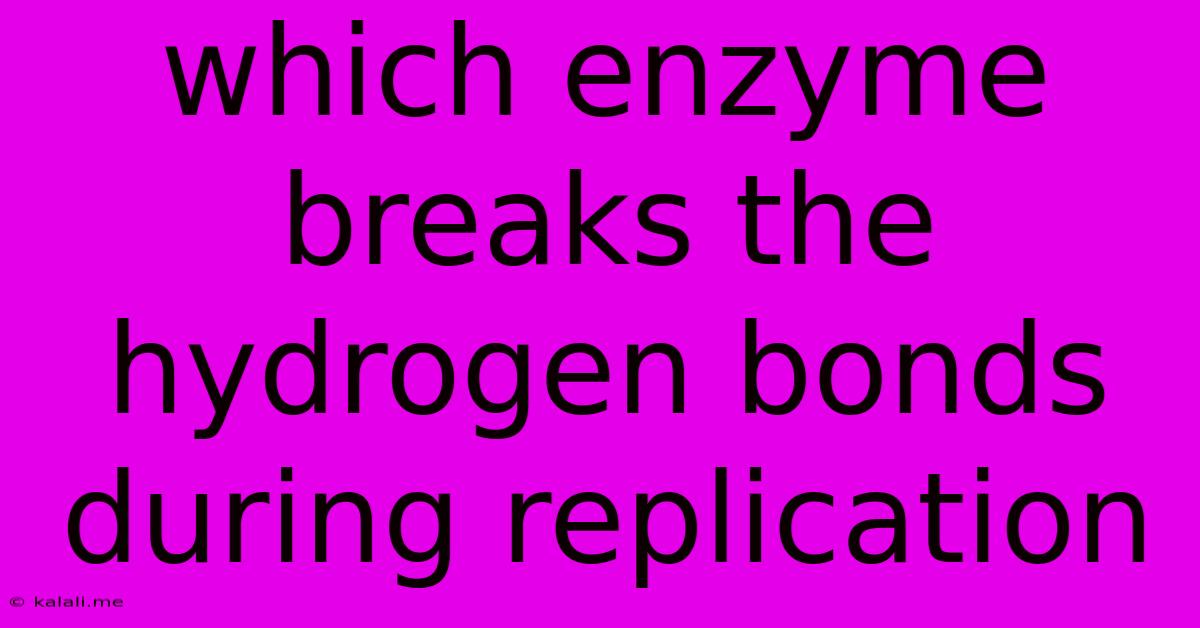Which Enzyme Breaks The Hydrogen Bonds During Replication
Kalali
May 09, 2025 · 3 min read

Table of Contents
Which Enzyme Breaks the Hydrogen Bonds During Replication?
Meta Description: DNA replication is a complex process, and understanding the role of enzymes like helicase is crucial. This article delves into the enzyme responsible for breaking hydrogen bonds during DNA replication, explaining its function and the broader context of the replication process.
DNA replication, the process by which a cell creates an exact copy of its DNA, is a fundamental aspect of cell growth and division. This intricate process involves a coordinated effort by numerous enzymes and proteins. One critical step is the separation of the two strands of the DNA double helix, a process made possible by the enzyme helicase. This article will delve into the role of helicase and its crucial function in breaking the hydrogen bonds that hold the DNA strands together.
Understanding the DNA Double Helix
Before we discuss the enzyme responsible for breaking hydrogen bonds, it's essential to understand the structure of DNA. DNA exists as a double helix, consisting of two complementary strands wound around each other. These strands are held together by hydrogen bonds formed between specific nitrogenous bases: adenine (A) pairs with thymine (T), and guanine (G) pairs with cytosine (C). These hydrogen bonds, while individually weak, collectively create a stable double helix structure. However, for replication to occur, these bonds must be broken to allow access to the individual DNA strands.
Helicase: The Unzipping Enzyme
The enzyme responsible for breaking the hydrogen bonds during DNA replication is helicase. Think of helicase as the "unzipping enzyme" – it unwinds the DNA double helix at the replication fork, separating the two strands. It does this by hydrolyzing ATP (adenosine triphosphate), using the energy released to break the hydrogen bonds between the base pairs. This creates a replication fork, a Y-shaped structure where the two strands are separated and ready for replication.
The process isn't simply a passive unwinding. The double helix is a tightly wound structure, and the unwinding process creates torsional strain ahead of the replication fork. To alleviate this strain and prevent supercoiling, other enzymes like topoisomerases are involved. Topoisomerases cut and rejoin the DNA strands, relieving the tension and allowing the helicase to continue its work.
Other Enzymes Involved in DNA Replication
While helicase plays a central role in breaking hydrogen bonds, several other enzymes are crucial for successful DNA replication. These include:
- Primase: Synthesizes short RNA primers to provide a starting point for DNA polymerase.
- DNA Polymerase: Adds nucleotides to the growing DNA strand, extending the RNA primer.
- Ligase: Joins Okazaki fragments together on the lagging strand.
- Single-strand binding proteins (SSBs): Prevent the separated DNA strands from reannealing.
The Importance of Accurate Replication
The accuracy of DNA replication is paramount for maintaining genetic integrity. Errors during replication can lead to mutations, which may have harmful consequences. The precise mechanism involving helicase and other enzymes ensures high fidelity replication, minimizing the risk of errors. The intricate dance of these molecular machines is a testament to the remarkable efficiency and precision of biological processes.
Conclusion
In summary, helicase is the primary enzyme responsible for breaking the hydrogen bonds during DNA replication. Its action, coupled with the work of other enzymes, ensures the accurate and efficient duplication of the genetic material, a fundamental process for all life. Understanding the role of helicase provides valuable insight into the complexities of molecular biology and the mechanisms that underpin life itself.
Latest Posts
Related Post
Thank you for visiting our website which covers about Which Enzyme Breaks The Hydrogen Bonds During Replication . We hope the information provided has been useful to you. Feel free to contact us if you have any questions or need further assistance. See you next time and don't miss to bookmark.